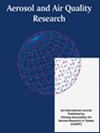基于两阶段正矩阵分解和稳健回归融合策略的PM2.5二次气溶胶表征
IF 2.5
4区 环境科学与生态学
Q3 ENVIRONMENTAL SCIENCES
引用次数: 0
摘要
正矩阵分解(PMF)是一种常用的PM2.5源分解受体模型。然而,PMF结果往往检索到主要由二次气溶胶组成的单个因子,因此难以与主要排放源联系起来并制定有效的空气污染控制策略。为了克服这一限制,我们采用了两阶段PMF建模方法,调整了物种权重,并将其与稳健回归模型相融合,以更好地表征PM2.5次生气溶胶的来源。此外,有机分子示踪剂掺入PMF进行来源鉴定。2021年5月至12月在台湾台中进行了一次实地活动。利用改进的PMF模型对3 h在线和24 h离线PM2.5成分测量的多时间分辨率数据进行求解。从PMF中检索到的因子在24小时间隔内平均,然后应用于稳健回归分析以重新分配贡献。与传统PMF相比,降低模型中与二次气溶胶相关的物种的权重更有效地将它们与主要排放源联系起来。融合模型结果表明,3 h内次生气溶胶的主要来源为石油燃烧,次生气溶胶相关物质总量为2.67 μ m-3,而24 h内次生气溶胶的最大来源为工业(1.65 μ m-3),需要在不同时间尺度上对这两种来源进行调控。两阶段PMF和稳健回归的融合策略提供了精确的结果,有助于PM2.5的管理。本文章由计算机程序翻译,如有差异,请以英文原文为准。
Characterizing PM2.5 Secondary Aerosols via a Fusion Strategy of Two-stage Positive Matrix Factorization and Robust Regression
Positive Matrix Factorization (PMF) is a commonly used receptor model for source apportionment of PM2.5. However, PMF results often retrieve an individual factor mainly composed of secondary aerosols, making it difficult to link with primary emission sources and formulate effective air pollution control strategies. To overcome this limitation, we employed a two-stage PMF modeling approach with adjustments of the species weighting, which was fused with a robust regression model to better characterize the sources of PM2.5 secondary aerosols. Additionally, organic molecular tracers were incorporated into PMF for source identification. A field campaign was conducted between May and December 2021 in Taichung, Taiwan. An improved PMF model was utilized to resolve the multiple time resolution data of 3-h online and 24-h offline measurements of PM2.5 compositions. Retrieved factors from PMF were averaged over 24-h intervals and then applied in robust regression analysis to re-apportion the contributions. Comparing with conventional PMF, downweighting the secondary aerosol-related species in the model was more effective in linking them to primary emission sources. The results from fusion models showed that the majority of secondary aerosols (sum of secondary aerosol-related species = 2.67 μg m-3) within three hours were mainly contributed by oil combustion, while the largest contributor of secondary aerosols (1.65 μg m-3) over 24 hours was industry, highlighting the need for regulation of these two sources based on various temporal scales. The developed fusion strategy of two-stage PMF and robust regression provided refined results and can aid in the management of PM2.5.
求助全文
通过发布文献求助,成功后即可免费获取论文全文。
去求助
来源期刊

Aerosol and Air Quality Research
ENVIRONMENTAL SCIENCES-
CiteScore
8.30
自引率
10.00%
发文量
163
审稿时长
3 months
期刊介绍:
The international journal of Aerosol and Air Quality Research (AAQR) covers all aspects of aerosol science and technology, atmospheric science and air quality related issues. It encompasses a multi-disciplinary field, including:
- Aerosol, air quality, atmospheric chemistry and global change;
- Air toxics (hazardous air pollutants (HAPs), persistent organic pollutants (POPs)) - Sources, control, transport and fate, human exposure;
- Nanoparticle and nanotechnology;
- Sources, combustion, thermal decomposition, emission, properties, behavior, formation, transport, deposition, measurement and analysis;
- Effects on the environments;
- Air quality and human health;
- Bioaerosols;
- Indoor air quality;
- Energy and air pollution;
- Pollution control technologies;
- Invention and improvement of sampling instruments and technologies;
- Optical/radiative properties and remote sensing;
- Carbon dioxide emission, capture, storage and utilization; novel methods for the reduction of carbon dioxide emission;
- Other topics related to aerosol and air quality.
 求助内容:
求助内容: 应助结果提醒方式:
应助结果提醒方式:


